Advantages/Disadvantages of ME?
#1
Burning Brakes



Thread Starter
I was unsuccessful searching for a thread which discussed the advantages and disadvantages of the ME for the "normal", everyday Corvette driver. With weight distribution in the C7 about as close to 50/50 as they can get, I'm wondering what the ME will provide that the C7 doesn't already offer.
IF this is a repeat thread, please delete.
IF this is a repeat thread, please delete.
#2
Supporting Vendor
Member Since: Dec 2016
Location: Lookin over Hoover Dam
Posts: 3,513
Received 2,314 Likes
on
990 Posts
This is all debatable from various angles and perspectives. I'll just add in a few details.
50/50 isn't ideal weight distribution. If this were the case F1, Indy, prototype racing and all other top forms would target that distribution. Rear weight bias has its advantages.
I'd point you to polar moment of inertia. Simply put, with all the weight in the middle (rear weight bias), and the drivetrain all compacted together, the car will rotate around that weight easier, then with an engine in front, torque tube in middle and transmission/diff in the rear. Go to the grocery store and put a pack of water in the middle or slightly rearward, then steer it around. Then, put water out front and another in the back...then steer. You'll have no doubts which is better.
Mid engine is a "supercar", performance targeted design. Front engine, rear drive is a Grant Touring targeted design. Comparing the two is apples to oranges. They serve different purposes, allow for different uses. I must reinforce, the mid engine "corvette" will NOT replace the front engine/rear drive Corvette. This is a supplement to the lineup, not a replacement.
GT platforms often have ingress/egress advantages, more luggage space, cooler/quieter driving environment, but that gap is closing with modern design techniques.
ME platforms have center of pressure variations from a GT FR platform. Using the front end for cooling only eliminates front lift due to engine bay turbulence, plus the undertray can be worked differently for aero qualities.
It'd take days to compare the two, but let racing speak for itself. The top tiers of racing are mid engine for a reason. We saw Nissan attempt to break that approach and do a front engine setup with the GTR LM in 2015. Well....lets just say there are a lot of people no longer employed by Nissan anymore. Nissan has flirted with extreme engine positions in the top levels of racing and it consistently hasn't gone too well. Kudos to them for tryin...
50/50 isn't ideal weight distribution. If this were the case F1, Indy, prototype racing and all other top forms would target that distribution. Rear weight bias has its advantages.
I'd point you to polar moment of inertia. Simply put, with all the weight in the middle (rear weight bias), and the drivetrain all compacted together, the car will rotate around that weight easier, then with an engine in front, torque tube in middle and transmission/diff in the rear. Go to the grocery store and put a pack of water in the middle or slightly rearward, then steer it around. Then, put water out front and another in the back...then steer. You'll have no doubts which is better.
Mid engine is a "supercar", performance targeted design. Front engine, rear drive is a Grant Touring targeted design. Comparing the two is apples to oranges. They serve different purposes, allow for different uses. I must reinforce, the mid engine "corvette" will NOT replace the front engine/rear drive Corvette. This is a supplement to the lineup, not a replacement.
GT platforms often have ingress/egress advantages, more luggage space, cooler/quieter driving environment, but that gap is closing with modern design techniques.
ME platforms have center of pressure variations from a GT FR platform. Using the front end for cooling only eliminates front lift due to engine bay turbulence, plus the undertray can be worked differently for aero qualities.
It'd take days to compare the two, but let racing speak for itself. The top tiers of racing are mid engine for a reason. We saw Nissan attempt to break that approach and do a front engine setup with the GTR LM in 2015. Well....lets just say there are a lot of people no longer employed by Nissan anymore. Nissan has flirted with extreme engine positions in the top levels of racing and it consistently hasn't gone too well. Kudos to them for tryin...
The following 5 users liked this post by KnightDriveTV:
Chemdawg99 (06-15-2017),
ElGreco53 (06-06-2017),
gurneyeagle (06-05-2017),
HC Mechanic (05-28-2017),
XC6VETTE (05-28-2017)
#3
Team Owner


You asked about a "normal everyday driver". That leaves out all forms of cars that are designed "only" to be raced such as F1, Indy, prototype etc. None of them are designed for the street.
On the street or even doing HPDE's, their is no difference in performance.
Thus, the other things the front engine layout has are all pluses. Easy to access the engine, etc, greater cargo carrying, more isolation from engine noises, etc.
My 1964 Corvette has a 47/53 weight distribution and a 16.5" center of gravity, and weighs 3125 pounds. Compare that to the C7 Stingray with it's 51/49 weight distribution, 17.5" center of gravity, and it's 3298 pounds.
Which car do you think preforms better, either on the street or on the track?
My 1964 had all those things that are pluses on a mid engine car(ie: greater weight distribution towards the rear, lower center of gravity, and less weight) yet it does not out corner a C7 Stingray on the street or on the track(where you are not fender banging racing, but 'wave to pass' driving).
On the street or even doing HPDE's, their is no difference in performance.
Thus, the other things the front engine layout has are all pluses. Easy to access the engine, etc, greater cargo carrying, more isolation from engine noises, etc.
My 1964 Corvette has a 47/53 weight distribution and a 16.5" center of gravity, and weighs 3125 pounds. Compare that to the C7 Stingray with it's 51/49 weight distribution, 17.5" center of gravity, and it's 3298 pounds.
Which car do you think preforms better, either on the street or on the track?
My 1964 had all those things that are pluses on a mid engine car(ie: greater weight distribution towards the rear, lower center of gravity, and less weight) yet it does not out corner a C7 Stingray on the street or on the track(where you are not fender banging racing, but 'wave to pass' driving).
Last edited by JoesC5; 05-27-2017 at 02:11 PM.
The following 2 users liked this post by JoesC5:
Chemdawg99 (06-15-2017),
pdiddy972 (06-10-2017)
#4
Burning Brakes



Thread Starter
This is all debatable from various angles and perspectives. I'll just add in a few details.
I'd point you to polar moment of inertia. Simply put, with all the weight in the middle (rear weight bias), and the drivetrain all compacted together, the car will rotate around that weight easier, then with an engine in front, torque tube in middle and transmission/diff in the rear. Go to the grocery store and put a pack of water in the middle or slightly rearward, then steer it around. Then, put water out front and another in the back...then steer. You'll have no doubts which is better.
Completely agree. However, with polar moment of inertia, once you do lose traction and start to spin...you're basically along for the ride.
Mid engine is a "supercar", performance targeted design. Front engine, rear drive is a Grant Touring targeted design. Comparing the two is apples to oranges. They serve different purposes, allow for different uses. I must reinforce, the mid engine "corvette" will NOT replace the front engine/rear drive Corvette. This is a supplement to the lineup, not a replacement.
Agree. Thus, the rub. Just not sure what "Corvette" market GM is trying to capture with the ME. The ME will most likely be too expensive for most of the 25-45 age group---assuming an entry level cost of around $75k or higher. Not sure value or draw for us "old farts"---50+. And I don't see many Porsche, Audi, Ferrari, McLaren, Lambo, etc., owners moving to the Corvette....those cars are "usually" status symbols for the ego-centric individual. That's a broad generalization and I know it doesn't apply to all owners---my apologies in advance to those who don't fit in the category.
I'd point you to polar moment of inertia. Simply put, with all the weight in the middle (rear weight bias), and the drivetrain all compacted together, the car will rotate around that weight easier, then with an engine in front, torque tube in middle and transmission/diff in the rear. Go to the grocery store and put a pack of water in the middle or slightly rearward, then steer it around. Then, put water out front and another in the back...then steer. You'll have no doubts which is better.
Completely agree. However, with polar moment of inertia, once you do lose traction and start to spin...you're basically along for the ride.
Mid engine is a "supercar", performance targeted design. Front engine, rear drive is a Grant Touring targeted design. Comparing the two is apples to oranges. They serve different purposes, allow for different uses. I must reinforce, the mid engine "corvette" will NOT replace the front engine/rear drive Corvette. This is a supplement to the lineup, not a replacement.
Agree. Thus, the rub. Just not sure what "Corvette" market GM is trying to capture with the ME. The ME will most likely be too expensive for most of the 25-45 age group---assuming an entry level cost of around $75k or higher. Not sure value or draw for us "old farts"---50+. And I don't see many Porsche, Audi, Ferrari, McLaren, Lambo, etc., owners moving to the Corvette....those cars are "usually" status symbols for the ego-centric individual. That's a broad generalization and I know it doesn't apply to all owners---my apologies in advance to those who don't fit in the category.
#5
The Consigliere
Member Since: May 2006
Location: 2023 Z06 & 2010 ZR1
Posts: 22,243
Received 5,432 Likes
on
2,268 Posts

For everyday driving, the superior traction from a rear ME platform would allow Corvette to continue adding power. It's at its limit with the current configuration on its ability to put the power down. That would be an immediately recognizable improvement for the everyday driver over the current platform. And is the main reason I really hope they build it/sell it. The platform would also allow for electric front motors for additional power assist/AWD capability more easily than the current platform (altho I personally have no interest in that; like ICE and no additional weight, personally).
The lower polar moment of inertia for handling has already been mentioned. Combined with the better weight transfer to the powered wheels, the everyday driver would have a rig easier to launch hard and enjoyable in the twisties.
The flip side of it - it gives up a meaningful (for some) measure of practicality and storage in the car. For some, that would be a big deal. For others (myself included), such would be a small price for a better platform and something I could deal with.
Also a minus - more difficult to cool the engine (although certainly doable) and the aero of the car itself would be a different ballgame for GM (i.e. learning curve). Ease of maintenance may or not me impacted over what we have now.
The lower polar moment of inertia for handling has already been mentioned. Combined with the better weight transfer to the powered wheels, the everyday driver would have a rig easier to launch hard and enjoyable in the twisties.
The flip side of it - it gives up a meaningful (for some) measure of practicality and storage in the car. For some, that would be a big deal. For others (myself included), such would be a small price for a better platform and something I could deal with.
Also a minus - more difficult to cool the engine (although certainly doable) and the aero of the car itself would be a different ballgame for GM (i.e. learning curve). Ease of maintenance may or not me impacted over what we have now.
#6
Team Owner


For everyday driving, the superior traction from a rear ME platform would allow Corvette to continue adding power. It's at its limit with the current configuration on its ability to put the power down. That would be an immediately recognizable improvement for the everyday driver over the current platform. And is the main reason I really hope they build it/sell it. The platform would also allow for electric front motors for additional power assist/AWD capability more easily than the current platform (altho I personally have no interest in that; like ICE and no additional weight, personally).
The lower polar moment of inertia for handling has already been mentioned. Combined with the better weight transfer to the powered wheels, the everyday driver would have a rig easier to launch hard and enjoyable in the twisties.
The flip side of it - it gives up a meaningful (for some) measure of practicality and storage in the car. For some, that would be a big deal. For others (myself included), such would be a small price for a better platform and something I could deal with.
Also a minus - more difficult to cool the engine (although certainly doable) and the aero of the car itself would be a different ballgame for GM (i.e. learning curve). Ease of maintenance may or not me impacted over what we have now.
The lower polar moment of inertia for handling has already been mentioned. Combined with the better weight transfer to the powered wheels, the everyday driver would have a rig easier to launch hard and enjoyable in the twisties.
The flip side of it - it gives up a meaningful (for some) measure of practicality and storage in the car. For some, that would be a big deal. For others (myself included), such would be a small price for a better platform and something I could deal with.
Also a minus - more difficult to cool the engine (although certainly doable) and the aero of the car itself would be a different ballgame for GM (i.e. learning curve). Ease of maintenance may or not me impacted over what we have now.
If that change were made to the C8, then the whole passenger compartment could be moved rearward about 10-12 inches, and then the engine could remain in front but be located further behind the front axle. That is how the weight distribution gets moved rearward and traction improves, and you would still have the benefits of the front engine platform.
No need to go to a mid engine design to change the weight distribution from 51/49 to a 47/53, meaning more of the car's weight is now on the rear tires. Plus, with the passenger compartment moved rearward, and when the passenger compartment is occupied, the driver's weight is now located further back increasing the weight over the rear wheels additionally.
The AMG GT R has a 47/53 weight distribution and with 577 horsepower it does 0-60 in 2.9 seconds.
The Acura NSX has a 42/58 weight distribution and with 573 horsepower it does 0-60 in 3.0 seconds. Slower, even though the NSX has some of that horsepower(electric motors) delivered through it's front wheels, whereas the AMG GT R has 100% of it's power delivered through it's two rear wheels.
Last edited by JoesC5; 05-28-2017 at 09:34 PM.
#7
Tech Contributor
Member Since: Oct 1999
Location: Charlotte, NC (formerly Endicott, NY)
Posts: 40,078
Received 8,919 Likes
on
5,328 Posts

Just changing the front mounted transmission to the differential(as is now in the C7) to have the transmission mounted behind the differential would mean a 47/53 weight distribution would be possible. That is a significant improvement over the present C7.
If that change were made to the C8, then the whole passenger compartment could be moved rearward about 10-12 inches, and then the engine could remain in front but be located further behind the front axle. That is how the weight distribution gets moved rearward and traction improves, and you would still have the benefits of the front engine platform.
No need to go to a mid engine design to change the weight distribution from 51/49 to a 47/53, meaning more of the car's weight is now on the rear tires. Plus, with the passenger compartment moved rearward, and when the passenger compartment is occupied, the driver's weight is now located further back increasing the weight over the rear wheels additionally.
If that change were made to the C8, then the whole passenger compartment could be moved rearward about 10-12 inches, and then the engine could remain in front but be located further behind the front axle. That is how the weight distribution gets moved rearward and traction improves, and you would still have the benefits of the front engine platform.
No need to go to a mid engine design to change the weight distribution from 51/49 to a 47/53, meaning more of the car's weight is now on the rear tires. Plus, with the passenger compartment moved rearward, and when the passenger compartment is occupied, the driver's weight is now located further back increasing the weight over the rear wheels additionally.
Bill
#8
Supporting Vendor
Member Since: Dec 2016
Location: Lookin over Hoover Dam
Posts: 3,513
Received 2,314 Likes
on
990 Posts
This is all debatable from various angles and perspectives. I'll just add in a few details.
I'd point you to polar moment of inertia. Simply put, with all the weight in the middle (rear weight bias), and the drivetrain all compacted together, the car will rotate around that weight easier, then with an engine in front, torque tube in middle and transmission/diff in the rear. Go to the grocery store and put a pack of water in the middle or slightly rearward, then steer it around. Then, put water out front and another in the back...then steer. You'll have no doubts which is better.
Completely agree. However, with polar moment of inertia, once you do lose traction and start to spin...you're basically along for the ride.
Mid engine is a "supercar", performance targeted design. Front engine, rear drive is a Grant Touring targeted design. Comparing the two is apples to oranges. They serve different purposes, allow for different uses. I must reinforce, the mid engine "corvette" will NOT replace the front engine/rear drive Corvette. This is a supplement to the lineup, not a replacement.
Agree. Thus, the rub. Just not sure what "Corvette" market GM is trying to capture with the ME. The ME will most likely be too expensive for most of the 25-45 age group---assuming an entry level cost of around $75k or higher. Not sure value or draw for us "old farts"---50+. And I don't see many Porsche, Audi, Ferrari, McLaren, Lambo, etc., owners moving to the Corvette....those cars are "usually" status symbols for the ego-centric individual. That's a broad generalization and I know it doesn't apply to all owners---my apologies in advance to those who don't fit in the category.
I'd point you to polar moment of inertia. Simply put, with all the weight in the middle (rear weight bias), and the drivetrain all compacted together, the car will rotate around that weight easier, then with an engine in front, torque tube in middle and transmission/diff in the rear. Go to the grocery store and put a pack of water in the middle or slightly rearward, then steer it around. Then, put water out front and another in the back...then steer. You'll have no doubts which is better.
Completely agree. However, with polar moment of inertia, once you do lose traction and start to spin...you're basically along for the ride.
Mid engine is a "supercar", performance targeted design. Front engine, rear drive is a Grant Touring targeted design. Comparing the two is apples to oranges. They serve different purposes, allow for different uses. I must reinforce, the mid engine "corvette" will NOT replace the front engine/rear drive Corvette. This is a supplement to the lineup, not a replacement.
Agree. Thus, the rub. Just not sure what "Corvette" market GM is trying to capture with the ME. The ME will most likely be too expensive for most of the 25-45 age group---assuming an entry level cost of around $75k or higher. Not sure value or draw for us "old farts"---50+. And I don't see many Porsche, Audi, Ferrari, McLaren, Lambo, etc., owners moving to the Corvette....those cars are "usually" status symbols for the ego-centric individual. That's a broad generalization and I know it doesn't apply to all owners---my apologies in advance to those who don't fit in the category.
I think GM has an opportunity to build something very special. Nothing super high tech, super high maintenance. Something the everyday guy can afford, and get repaired. I think it's the next level GM really needs.
Bob Lutz put it best. GM is one of the only remaining brands that has all the expertise in house to build anything it wants. It can do hybrid, electric, supercars, engines, etc. It's time they put out the next level.
On the demo side of it...I know plenty of guys under 35 driving 100k cars with another 50k in mods. There's a market for sure. It doesn't have to be a huge market, just a "loud" market. Hence how Ford marketed the GT....they wanted visibility, not quantity.
I'm hoping for a modern day NSX essentially. Nothing too tech, still a real driver car built in the modern day. Germans and Japanese have already checked out when it comes to a raw supercar, but I think America can still build it.
Just let it happen....they know what they're doing.
#9
Team Owner


Mounting the transmission behind the diff in a front ME car like the Corvette is could cause issues due to how you would route the power flow from engine to trans. Of course they could use a chain drive like the Oldsmobile Toronado used to have. That way they could mount the engine directly over the rear axle just like the Toronado engine sat over the front axle. I doubt that would work because it would raise a lot of weight much higher in the car.
Bill
Bill
This photo is of the C7. Kindly notice that it has a front mounted engine with the power going through the torque tube into the transmission that is mounted in front of the differential, and then into the differential.
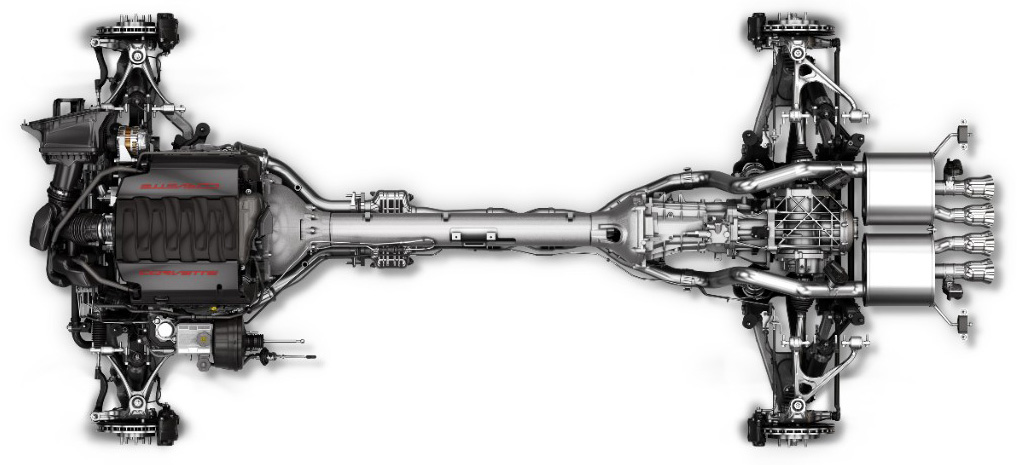
This photo is of the Mercedes AMG GT. Kindly notice that it has a front mounted engine with the power going through the torque tube into the transmission that is mounted behind the differential. The transmission is designed to then route the power 180 degrees(without using a chain) into the differential.
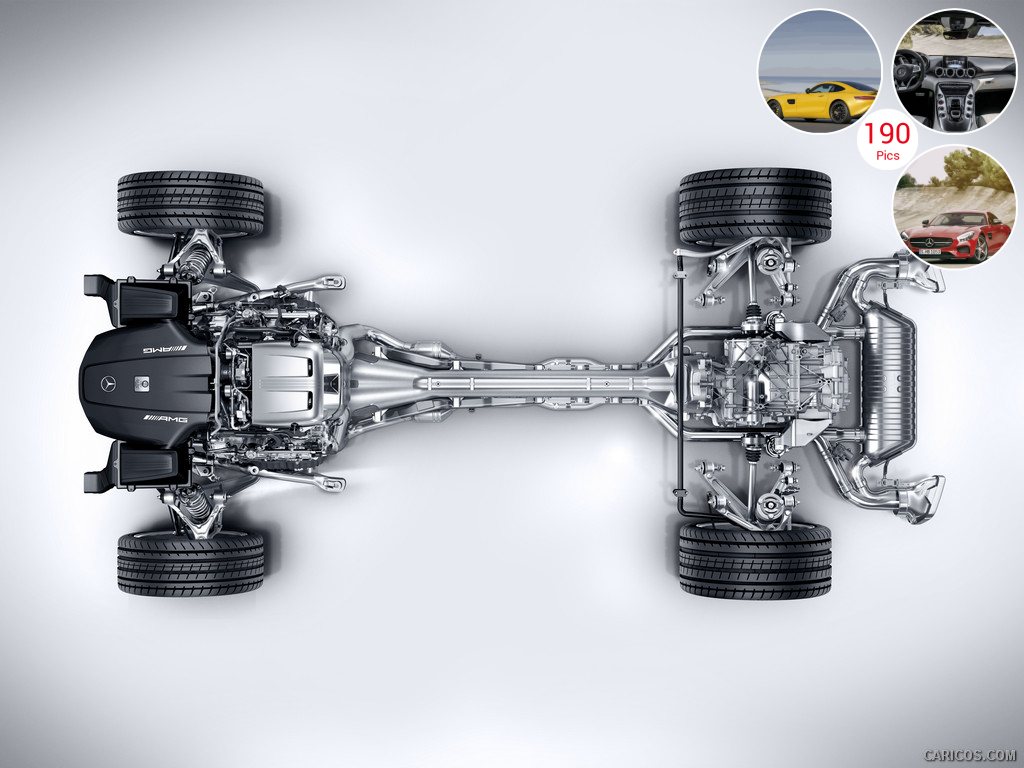
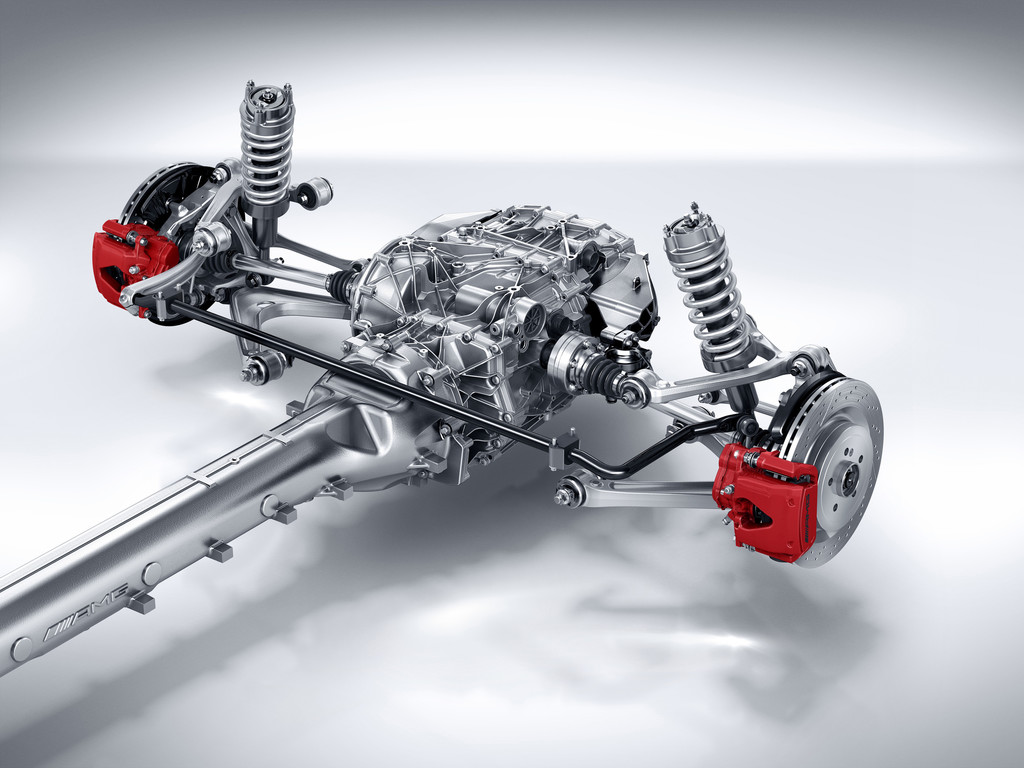
If you can understand the photos, then you will see why the passenger compartment is located closer to the rear axle on the AMG GT than with the C7 and you will see why the AMG GT has a better weight distribution(47/53) than the C7.
Here is a photo of the Porsche transaxle(from the Boxster) that has the bellhousing on the right(that bolts to the engine or can bolted to a torque tube like is used in the C7 and the AMG GT)with the power going into the transmission that is located behind the differential, and the power is then directed 180 degrees to go to the pinon and ring gear in the differential. The photo is perfectly clear as to how this happens. No chains, belts or ropes required. This design transaxle does not raise the mass to a higher point than the mass of the C7's transaxle. No change in the height of the center of gravity as you claim.
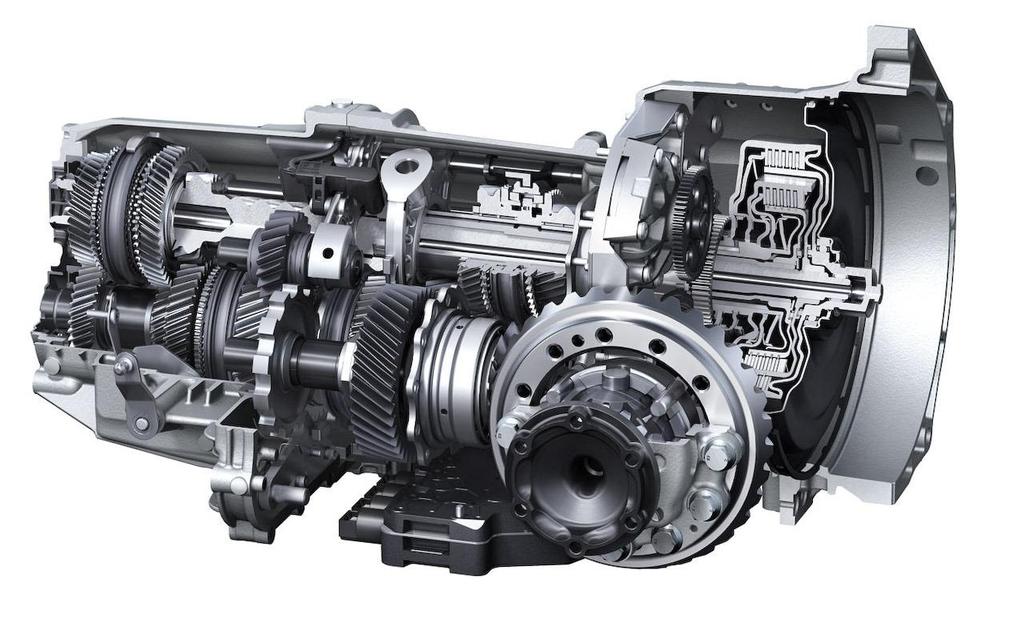
If GM does release a mid engine car(whether it be as a Corvette and/or a Cadillac) the transmission will have to be located behind the differential(if you don't want to share the passenger compartment with the engine). That same transmission can then be shared with the front engine C8(economies of scale) to help lower the cost of the transmission.
Speaking of mid engine cars from GM, notice how the muffler and tailpipes are designed on the AMG GT in the photo above. Now look at the photos of the camo'd mid engine GM car and its exhaust pipes and muffler(behind the expanded meal screen). Clear indication that the mid engine GM car has a transaxle with the transmission located behind the differential.

Here is a photo of a mid engine car under construction that uses a Chevy LS engine bolted to a transaxle that has the transmission located behind the differential. If you wanted this particular car to be a front engine design, then stick a 6' long torque tube between the engine and the transaxle., and locate the passenger compartment as close to the rear axle as possible.
AS can be clearly seen, if the transmission was located between the engine and the differential, then the engine would be sitting between the driver's and the passenger's seats, making for a very uncomfortable ride.
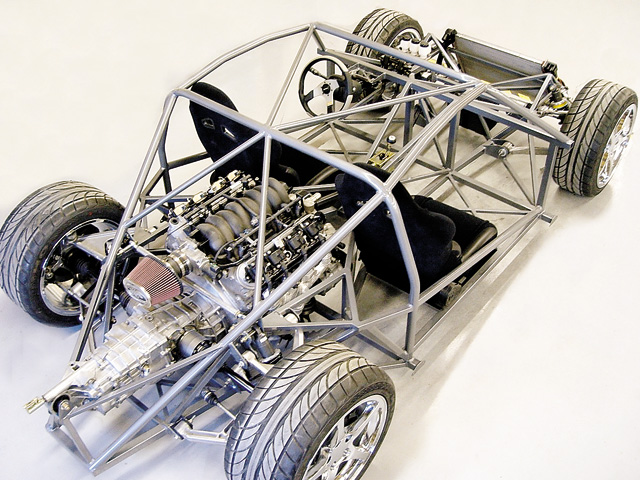
Also notice that with the design of this particular transaxle, the center of gravity is very low.
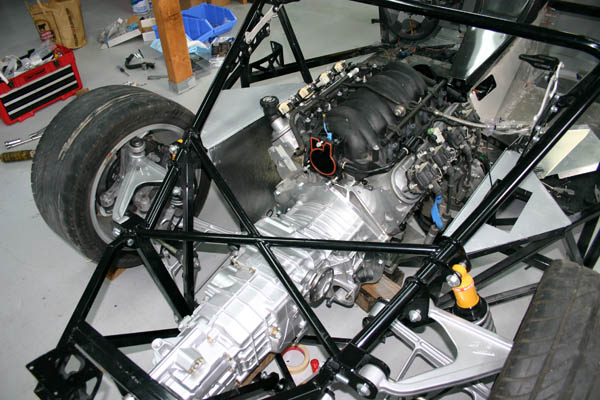
Last edited by JoesC5; 05-28-2017 at 02:36 PM.
The following 4 users liked this post by JoesC5:
#10
Le Mans Master


If GM does release a mid engine car(whether it be as a Corvette and/or a Cadillac) the transmission will have to be located behind the differential(if you don't want to share the passenger compartment with the engine). That same transmission can then be shared with the front engine C8(economies of scale) to help lower the cost of the transmission.

Also need to consider the racing/marketing side of all this. You're elevating the brand with a real HALO. A car that can trickle down tech, have a global presence on the racetrack, expand the brand, etc.
I think GM has an opportunity to build something very special. Nothing super high tech, super high maintenance. Something the everyday guy can afford, and get repaired. I think it's the next level GM really needs.
Bob Lutz put it best. GM is one of the only remaining brands that has all the expertise in house to build anything it wants. It can do hybrid, electric, supercars, engines, etc. It's time they put out the next level.
On the demo side of it...I know plenty of guys under 35 driving 100k cars with another 50k in mods. There's a market for sure. It doesn't have to be a huge market, just a "loud" market. Hence how Ford marketed the GT....they wanted visibility, not quantity.
I'm hoping for a modern day NSX essentially. Nothing too tech, still a real driver car built in the modern day. Germans and Japanese have already checked out when it comes to a raw supercar, but I think America can still build it.
Just let it happen....they know what they're doing.
I think GM has an opportunity to build something very special. Nothing super high tech, super high maintenance. Something the everyday guy can afford, and get repaired. I think it's the next level GM really needs.
Bob Lutz put it best. GM is one of the only remaining brands that has all the expertise in house to build anything it wants. It can do hybrid, electric, supercars, engines, etc. It's time they put out the next level.
On the demo side of it...I know plenty of guys under 35 driving 100k cars with another 50k in mods. There's a market for sure. It doesn't have to be a huge market, just a "loud" market. Hence how Ford marketed the GT....they wanted visibility, not quantity.
I'm hoping for a modern day NSX essentially. Nothing too tech, still a real driver car built in the modern day. Germans and Japanese have already checked out when it comes to a raw supercar, but I think America can still build it.
Just let it happen....they know what they're doing.
I was unsuccessful searching for a thread which discussed the advantages and disadvantages of the ME for the "normal", everyday Corvette driver. With weight distribution in the C7 about as close to 50/50 as they can get, I'm wondering what the ME will provide that the C7 doesn't already offer.
IF this is a repeat thread, please delete.
IF this is a repeat thread, please delete.
A rear weight bias is preferred over 50/50 for ultimate performance.
Last edited by Steve Garrett; 05-28-2017 at 08:57 PM. Reason: Merged Posts-please use the Multi-Quote button (the middle icon) in the lower right hand corner of each post to make your responses look like this!
#11
Melting Slicks


The biggest advantage is that you don't need to keep the front of the car high enough to clear the engine, so if done correctly, making the seat lower, and without the need for a clutch pedal GM could probably get a ME car down to about 42" in height from the current car's 48". Lower CG and a 40/60 weight bias will get the car to be the best performing Corvette ever.
Downside, it will be as practical as a dedicated race car.
Downside, it will be as practical as a dedicated race car.
#13
Le Mans Master


ME Advantages:
Lower=better aero.
Less exhaust system weight, and no torque tube weight.
Lower polar moment of inertia.
More weight on the drive wheels.
Less weight transfer during breaking.
Typically sleeker styling (Cayman excluded )
)
Michael
Lower=better aero.
Less exhaust system weight, and no torque tube weight.
Lower polar moment of inertia.
More weight on the drive wheels.
Less weight transfer during breaking.
Typically sleeker styling (Cayman excluded
 )
)Michael
#14
Team Owner


Front engine 1997 Corvette Cd of .29 and height of 47.7 inches.
Mid engine 2017 Acura NSX Cd of .30 and height of 47.8 inches.
Tesla S 4 door sedan Cd of .24 and height of 56.5 inches.
The newest mid engine design car sports car/GT(NSX) has no better aero or less height than the 20 year old C5. Actually, not quite as good as the C5. What the NSX did give up is nearly 20.6 cu ft of cargo room vs the C5. Actually, the length of the car is more important in lowering the Cd than the height of the hood. I bet most Corvette owners would rather have comfortable head room and a decent size cargo capacity, on that 2,500 mile road trip then a slightly lower Cd combined with a ultra small area to pack any luggage, just to lower the "polar moment of inertia" or change the front/rear weight distribution from 47/53 to 42/58.
The 1997 C5(with it's steel frame) weighed 3,224 pounds vs the NSX(with it's aluminum frame) that weighs 3803 pounds.
The NSX has a 42/58 weight distribution but the front engine AMG GT R is 47/53. On the street(where 95%+ of the car's mileage will be accumulated), I really doubt that you can tell the difference in g's pulled or stopping distance 0-60, between the NSX and the AMG GT R. We know the GT R has done the Ring in 7:10. That's going to be a hard number to beat in a GT/sports car(not a car that is designed for the track), even if it's a mid engine.
Most people do not drop $150,000 for a dedicated track car that isn't registered for the street. They normally buy a street car that is pretty good on the street(acceleration, cornering, braking) and a few do HPDE's(that is not real fender banging racing) with "wave to pass" passing with their street cars.
Have you ever wondered why the 707 HP Dodge Charger Hellcat has 204 MPH top speed(and a 58.3" roof height) over the 707 HP Dodge Challenger Hellcat that has 199 MPH top speed even though it has a 2.6" lower roof(55.7") than the Charger? Maybe there is more to aero efficiency than just the height of the hood/car.
I wonder what the "polar moment of inertia" is on my 1964 Corvette that has a 99" wheelbase and the entire engine, transmission and passenger compartment is located 100% between the axles, vs a mid engine car with a longer wheelbase(NSX is 103.5" and the C7 is 106.7" with it's longer V8 vs the much smaller NSX's V6)) and only the engine and passenger compartment is between the axles, as the transmission is hung out behind the rear axle.
Last edited by JoesC5; 06-05-2017 at 02:42 PM.
The following 2 users liked this post by JoesC5:
Chemdawg99 (06-15-2017),
pdiddy972 (06-07-2017)
#15
Team Owner


The biggest advantage is that you don't need to keep the front of the car high enough to clear the engine, so if done correctly, making the seat lower, and without the need for a clutch pedal GM could probably get a ME car down to about 42" in height from the current car's 48". Lower CG and a 40/60 weight bias will get the car to be the best performing Corvette ever.
Downside, it will be as practical as a dedicated race car.
Downside, it will be as practical as a dedicated race car.
You should take a closer look at just close the seat is to the floorboard actually is. Are you suggesting that the floorboard should be lowered 6"? To maintain a ~5" ground clearance, that is entirely out of the question.
Or, are you suggesting that all the padding, springs, electric motor/seat adjustment, etc be removed from the bottom of the seat so your butt can sit directly on the floorboard in order to have the same headroom but with a 42" high roof? The rear most part of my C6 Z06's seat bottom is just 5.5" above the floorboard, and I imagine that the seat bottom/foam/springs compresses at least an inch when I sit down in the seat. That leaves just 4.5" to lower the roof(and maintain the same headroom as I now have), and I'll be sitting directly on the hard floorboard.
Maybe design the seats so the seat backs are reclined at a 45 degree angle to maintain the same head room but with a 6" lower roof.
Absolutely no one would buy a mid engine Corvette that is to be driven on the street, if you did any of the above in order to lower the height of the car 6".
Most Corvettes are owned by us "old farts" and we have enough problems getting in and out of our 48" high Corvettes and have no desire to try it with a 42" high Corvette.
Last edited by JoesC5; 06-05-2017 at 03:04 PM.
The following users liked this post:
Chemdawg99 (06-15-2017)
#17
Melting Slicks


6" drop in the height of the roof by lowering the seat 6"????????????
You should take a closer look at just close the seat is to the floorboard actually is. Are you suggesting that the floorboard should be lowered 6"? To maintain a ~5" ground clearance, that is entirely out of the question.
Or, are you suggesting that all the padding, springs, electric motor/seat adjustment, etc be removed from the bottom of the seat so your butt can sit directly on the floorboard in order to have the same headroom but with a 42" high roof? The rear most part of my C6 Z06's seat bottom is just 5.5" above the floorboard, and I imagine that the seat bottom/foam/springs compresses at least an inch when I sit down in the seat. That leaves just 4.5" to lower the roof(and maintain the same headroom as I now have), and I'll be sitting directly on the hard floorboard.
Maybe design the seats so the seat backs are reclined at a 45 degree angle to maintain the same head room but with a 6" lower roof.
Absolutely no one would buy a mid engine Corvette that is to be driven on the street, if you did any of the above in order to lower the height of the car 6".
Most Corvettes are owned by us "old farts" and we have enough problems getting in and out of our 48" high Corvettes and have no desire to try it with a 42" high Corvette.
You should take a closer look at just close the seat is to the floorboard actually is. Are you suggesting that the floorboard should be lowered 6"? To maintain a ~5" ground clearance, that is entirely out of the question.
Or, are you suggesting that all the padding, springs, electric motor/seat adjustment, etc be removed from the bottom of the seat so your butt can sit directly on the floorboard in order to have the same headroom but with a 42" high roof? The rear most part of my C6 Z06's seat bottom is just 5.5" above the floorboard, and I imagine that the seat bottom/foam/springs compresses at least an inch when I sit down in the seat. That leaves just 4.5" to lower the roof(and maintain the same headroom as I now have), and I'll be sitting directly on the hard floorboard.
Maybe design the seats so the seat backs are reclined at a 45 degree angle to maintain the same head room but with a 6" lower roof.
Absolutely no one would buy a mid engine Corvette that is to be driven on the street, if you did any of the above in order to lower the height of the car 6".
Most Corvettes are owned by us "old farts" and we have enough problems getting in and out of our 48" high Corvettes and have no desire to try it with a 42" high Corvette.
Also, the projected market for the ME is much younger than the current demographic.
#18
The original Ford GT 40 was 40.4" high, the 2005 Ford GT was 44" high, and the current Ford GT is 41.7" (at low ride height - 43.2" at standard) - there is no reason a world beating mid-engine Corvette can't be 42" tall - if GM needs to, they can make the car so that it has a more reclined seat angle, and only fits people up to 6'2" tall.
Also, the projected market for the ME is much younger than the current demographic.
Also, the projected market for the ME is much younger than the current demographic.
The following users liked this post:
Chemdawg99 (06-15-2017)
#20
The original Ford GT 40 was 40.4" high, the 2005 Ford GT was 44" high, and the current Ford GT is 41.7" (at low ride height - 43.2" at standard) - there is no reason a world beating mid-engine Corvette can't be 42" tall - if GM needs to, they can make the car so that it has a more reclined seat angle, and only fits people up to 6'2" tall.
Also, the projected market for the ME is much younger than the current demographic.
Also, the projected market for the ME is much younger than the current demographic.
-
I wouldn't concern myself at all at trying to reduce the overall height. Have you seen a Lotus on the road? It's not good. It looks like a little go-cart. Sometimes Lamborghinis look too small too. Bigger is better. Just do what looks good, and that will probably fit most everybody.





